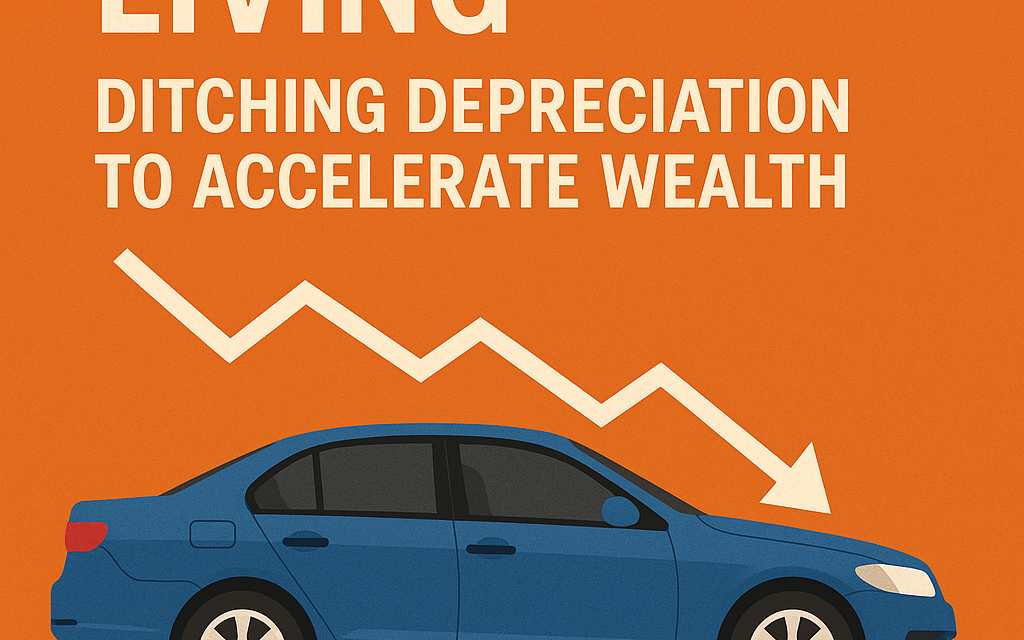Car‑Light Living: Ditching Depreciation to Accelerate Wealth
Summary: Cars are useful—but expensive, fast‑depreciating tools. A car‑light lifestyle blends walking, cycling, transit, car‑share, and selective driving so you keep mobility while redirecting thousands of dollars a year toward investments.
Why “ditch depreciation”?
Unlike assets that appreciate or generate income, personal vehicles typically lose value every year. Meanwhile, you still pay for insurance, fuel, maintenance, registration, parking, and financing. Many households effectively spend the equivalent of a second rent or mortgage on transportation.
- Depreciation: New cars commonly lose a large chunk of value in the first few years, then continue to slide.
- Carrying costs: Insurance, fuel, maintenance/repairs, registration, tolls, parking, interest, and taxes add up—whether or not you drive much.
- Opportunity cost: Every dollar tied up in a rapidly depreciating item is a dollar not compounding for your future.
What is car‑light living?
Car‑light living means minimizing private car ownership and use without sacrificing mobility. Most people do one of the following:
- Keep one older, reliable car but reduce miles driven dramatically.
- Go car‑free and pair transit, cycling, walking, ride‑hailing, car‑share, and short‑term rentals to cover trips.
The goal isn’t austerity—it’s fit‑for‑purpose mobility at far lower cost.
The simple math: cost today, wealth tomorrow
Below are illustrative monthly budgets. Your numbers will vary by city, commute, vehicle, insurance profile, and parking situation, but the pattern is consistent.
Scenario A: Two newer cars
- Payments (2 cars): ~$1,200
- Insurance: ~$300
- Fuel + maintenance: ~$350
- Parking/tolls/fees: ~$100
- Total per month: ~$1,950 (≈ $23,400/year)
Scenario B: One paid‑off used car + “mobility stack”
- Maintenance + sinking fund for replacement: ~$250
- Insurance: ~$120
- Fuel/tires: ~$150
- Parking/tolls/fees: ~$60
- Transit pass + occasional ride‑hail/car‑share: ~$150
- Total per month: ~$730 (≈ $8,760/year)
Scenario C: Car‑free in a transit‑served area
- Transit pass: ~$80–$150
- Ride‑hail/car‑share/rentals: ~$150–$250
- Bike/scooter upkeep and incidentals: ~$30–$50
- Total per month: ~$260–$450 (≈ $3,120–$5,400/year)
Potential savings: Moving from Scenario A to B frees roughly $14,000–$16,000/year; A to C can free ~$18,000/year. If you invest $8,000/year of that at a 7% long‑term return, you could have about $110,000 in 10 years. At $12,000/year, that’s about $166,000 in 10 years. These are estimates, not guarantees.
Build your “mobility stack”
Mix and match based on your city and lifestyle. Aim for the cheapest effective mode for each trip type.
- Walking + errands clustering: Combine trips; choose housing or errands near daily needs.
- Cycling or e‑bike: 1–5 mile trips become 10–20 minute rides; e‑bikes flatten hills and heat.
- Public transit: Monthly passes often beat per‑ride fares if you commute or ride often.
- Car‑share and short‑term rentals: Use for big‑box runs, IKEA hauls, or weekend trips.
- Ride‑hail/taxis: Great for late nights or bad weather; keep as the exception, not the rule.
- Workplace flexibility: Remote/hybrid days reduce peak travel needs dramatically.
If you keep a car, make it wealth‑friendly
- Buy used, reliable, and simple: Let someone else pay early depreciation; prioritize total cost of ownership (TCO), not just sticker price.
- Right‑size the vehicle: Drive the smallest vehicle that fits 95% of your life; rent the outlier vehicle when needed.
- Self‑insure the small stuff: Choose higher deductibles you can afford; keep a maintenance/emergency fund.
- Drive fewer miles: Fewer miles means less wear, lower fuel, and often lower insurance premiums.
- Mind the “5:1 wealth‑to‑wheels” rule: Keep liquid net worth at least five times the value of your vehicle(s). If not, your car is too expensive for your balance sheet.
A practical 30‑day plan to go car‑light
- Days 1–3: Baseline — Track all trips and costs: mileage, fuel, parking, tolls, insurance, payments.
- Days 4–7: Map alternatives — Identify transit routes, safe bike paths, nearby car‑share pods, and rental locations.
- Days 8–14: Pilot week — Replace three routine car trips with non‑car options; test an e‑bike or car‑share.
- Days 15–21: Optimize — Cluster errands; shift gym/shopping closer; set up delivery for bulky items.
- Days 22–30: Commit — Drop to one household car or pause a lease; buy a transit pass; set an automatic monthly “transport savings” investment.
Safety and comfort tips
- Choose well‑lit routes and carry lights for night riding/walking.
- Use quality locks and a basic repair kit for bikes/e‑bikes.
- Keep weather‑proof layers and a compact umbrella at work or in your bag.
- Know your city’s off‑peak transit hours for quieter, faster rides.
Families and lower‑density areas
Car‑light is still possible outside dense cities—just different:
- One‑car households: Share a calendar; batch kid activities; use carpools.
- Cargo solutions: Cargo bikes, trailers, or occasional SUV rentals cover big hauls.
- Destination density: Anchor frequent activities (school, groceries, gym) within a tight radius.
Quick tools to make it stick
- TCO tracker: Spreadsheet or app to log every car expense; review monthly.
- Mobility wallet: Preload a set monthly amount for transit/car‑share/ride‑hail.
- Automatic investing: Redirect the difference between old and new transport costs on payday.
- Annual “sell test”: Ask: If I didn’t own this car today, would I buy it at its current market value?
FAQs
Is car‑light living all‑or‑nothing? No. Even cutting miles by 30–50% can free real money and time.
What about time cost? Many trips take similar time when you factor in parking and traffic. Use the fastest mode for the job, not the most habitual.
Do I lose freedom? Most people report they gain options—especially for short trips—while renting a car for edge cases.
Key takeaways
- Personal cars are expensive and depreciate quickly; driving less or owning fewer amplifies your savings.
- A tailored “mobility stack” can meet nearly all trips for a fraction of the cost.
- Redirect savings automatically into investments to turn lower expenses into growing wealth.
Not financial advice. Investment returns vary and are not guaranteed. Use local safety guidance and traffic laws.





